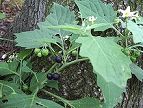With three Community workdays since November, we have weeded, spread cardboard and mulch, and removed tree guards.
Apologies again to those who came for the last work day in February - I had convinced myself the 22nd was the second last Sunday of the month.
The grasslands south of the billabong and the golf course triangle were mowed in late December to reduce the fire hazard. The verges and picnic areas have also been regularly mowed.
Our contractor, Mark Douglas of Bushland recovery has done more weed control spraying in the golf course triangle and around the billabong area, and the results look great! The blackberries throughout the reserve proper are nearly all gone, and I have been able to get the ride-on into the northernmost areas of the golf course triangle for the first time.

I joked about the “Burke Rd. Billabong resort” when we got the shipping container, but someone has taken me seriously and set up camp in the northern section of the golf course triangle. It must have taken some effort to get the chair there.

One of the good signs in revegetation is when the indigenous plants brought back to the reserve start self-seeding. This kangaroo apple growing in the fork of the big gum near the picnic area is just one of many to self seed.
WILDLIFE
At the bat checks, the bats numbers have been variable with a half a dozen one month and then 30 the next. The kangaroo has been seen intermittently and there are reports of a wallaby in the reserve and on the Banyule side.
Solanum – nightshade (Latin)
nigrum – black (Latin)
European black nightshade or just "nightshade", is a species in the Solanum genus, native to Eurasia and introduced in the Americas, Australasia and South Africa. Parts of this plant can be toxic to livestock and humans, and it's considered a weed. Nonetheless, ripe berries and cooked leaves of edible strains are used as food in some places; and plant parts are used as a traditional medicine.

Nightshade is a common herb or short-lived perennial shrub, found in many wooded areas, as well as disturbed habitats. It has a height of 30 to 120 cm, and leaves 4 to 7.5 cm long. The flowers have petals greenish to whitish. The berry is mostly 6 to 8 mm diam., dull black or purple-black.
The plant has a long history of medicinal usage, dating back to ancient Greece. It was a traditional European medicine used as a strong sudorific, analgesic and sedative with powerful narcotic properties, but was considered a "somewhat dangerous remedy” due to its variable chemistry and toxicity. It is used topically as a treatment for herpes.
http://en.wikipedia.org/wiki/Solanum_nigrum
There appears to be a large nightshade seed bank in the areas of the reserve cleared of Tradescantia.
FRIDAY 13 MARCH 2015
9:30 a.m. to 1 p.m.
&
SUNDAY 29 MARCH 2015
9:30 a.m. to 1 p.m.
Stanley Barker,
Burke Rd. Billabong Committee of Management.
www.brbreserve.org